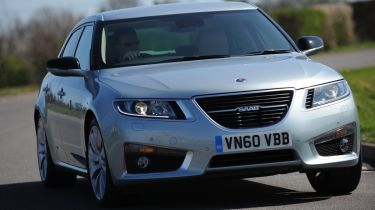Saab 9-5
Swedes have slashed price, which makes our big exec look more tempting than ever
Don't worry, I’m not trying to sell our long-term 9-5. But if that was my plan, Saab has just made the job a whole lot easier. Although the firm is in short-term financial trouble at the moment, UK bosses’ latest move ensures the executive car is more attractive than ever.
After glancing through a list of the improvements, I did a quick reappraisal of our model, as anyone ordering a new 9-5 now will benefit from a host of extra kit as standard. When our 9-5 Aero 2.0 TTiD arrived earlier in the year, essentials such as sat-nav (£1,230), a DAB radio (£310) and DriveSense adaptive chassis (£975) all commanded a premium. But not any more.
These desirable extras have been added to the standard kit list on the latest models, and prices are slashed, too. As a result, the on-the-road price of our 9-5 has effectively dropped from £37,023 to £33,328. That’s a staggering £3,695 reduction.
And our example’s total still includes add-ons like metallic paint (£540), adaptive lights (£410), the Convenience Pack Plus (£515), privacy glass (£310) and detachable towbar (£558). So the new Saab is better value than
ever – but how is our model coping with life on the Auto Express fleet? Well, since our last report (Issue 1,169), we’ve added 3,688 miles and overall economy has dropped back to 38.5mpg –still pretty good for a vehicle measuring five metres long.
Used - available now

2021 Volkswagen
Polo GTI
54,017 milesAutomaticPetrol2.0L
Cash £15,397
2023 Ford
Focus
33,291 milesManualPetrol1.0L
Cash £15,397
2025 Vauxhall
Corsa
23,903 milesAutomaticPetrol1.2L
Cash £15,297
2023 Audi
Q3
55,572 milesAutomaticDiesel2.0L
Cash £22,197The 9-5 still splits opinion in the office, though. Many critics complain about the lack of true Saab heritage in its design and construction, while the gruff nature of its 2.0-litre TTiD diesel has also marked the car down.
It’s hard to argue with either criticism, and even Saab’s engineers aren’t 100 per cent happy with the installation and performance of the twin-turbo unit. A revised dashboard finish, in addition to the more competitive price, should help
to appease buyers in new car showrooms, though. And either way, I still enjoy spending time behind the wheel; superb mile-munching ability and motorway comfort make the Saab a fine cruiser on long trips.
Another positive is the car’s rarity value – the distinctive design makes it one of the most striking members of our fleet, in my eyes. Trouble is, this exclusivity is one of the biggest headaches for bosses; they’d love to see more on the road. Add it to the uncertainty over Saab’s future, and used values have been hit hard – if we traded ours in for a younger model, we could expect to get less than £20,000 back in part-exchange.
Yet my enthusiasm for the brand remains undimmed. If Saab can overcome its current cashflow problems, the latest changes to the 9-5 line-up and the imminent arrival of the practical Sportwagon estate version provide plenty of hope for the future.



